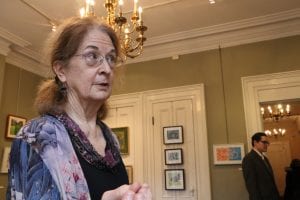Dec
2018
DVP Final Project: Video Interview

“I aim to make my work a counterweight to destructive forces operating in the world. Since the surest way to predict my own future is to try to create it myself, I look for inspiration in light and color. As a painter of landscape and still life, I choose to create images inspired by nature’s energies. Giving visible shape to my internal vision fosters healing in myself and others, moving artist and viewer alike from where we are toward some better place.”
-Annie Shaver-Crandell
Annie Shaver-Crandell sits across from me on a wide bench seat with floral pillows. Green fronds from potted plants grow unruly, crawling to the window by her corner. She wears jeans and a paint-stained dress shirt. The late afternoon light trickles through the window, painting her face with a soft glow. I fumble with the camera and the tripod, forgetting the questions I meant to ask. I think I arrived right after she woke up. She watches me patiently, stoically. We have met twice before, under the pretenses of a family affairs. I know little of her, except that she is distantly related too my boyfriend, and is an artist. She’s sort of intimidating, despite her relaxed posture. I stumble over words and say “Umm” a lot. She says, “I’m putty in your hands. ” Then we begin.
Originally from Oberlin Ohio, Annie Shaver-Crandell moved to New York City to pursue a graduate education in Art History, specializing as a Renaissance and Medievalist art historian. She taught at City College of New York, and is now a semi-retired painter. For the last 50 years, she has resided in NYC in her NoHo loft, where she also teaches art classes in the sunny, spacious back studio. She reminds me not to take pictures of her students work, which litters some of the easels. “I don’t even make a mark on my students work without their permission,” she says. “I hate when teachers do that.”
Within her apartment, the walls are a gallery of oil or watercolor Still Life paintings and Monotype prints. Much of her work is based on nature: flowers, animals, or scenery. Her paintings have spontaneous brushwork, energetic colors, and soft edges. Its easy to see the influence of impressionist painters. Because much of her work is done “Plein Air” style, the images must be captured in the moment. Light and subject matter are impermanent, so quick brushwork is the only way to ensure that she can capture the essence of what she sees. She also has a sort of “so what” attitude to painting: Make one and go on to the next.
One can observe many types of opposition in her work: spontaneity and control, light and dark, color and contrast, and even in her own life of city living and nature escapes. She says she’s attracted to “boundaries,” something particularly apparent in her Plein Air paintings. The boundaries in her paintings feel expansive though. They offer serenity without redundancy, and vibrate with color. There is an emphasis on the separation of land by water or sky, and afterwards, from a colorful painting and a white gallery wall.







